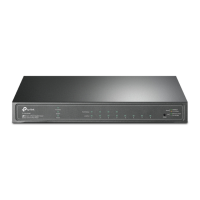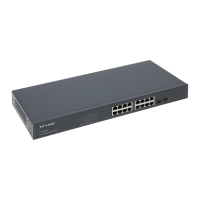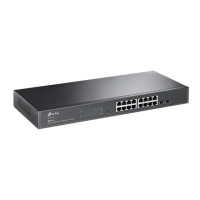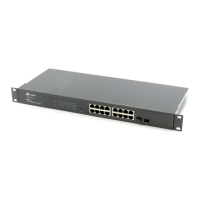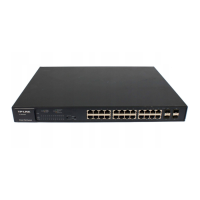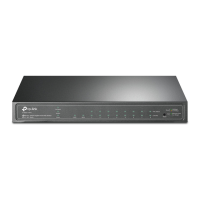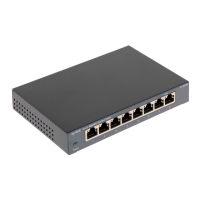Do you have a question about the TP-Link TL-SG2008 and is the answer not in the manual?
Identifies the target audience for this user guide, focusing on network managers familiar with IT concepts.
Explains the conventions used in the guide, including terminology and formatting for clarity.
Provides a summary of the guide's structure, outlining the content of each chapter.
Introduces the TL-SG2008 switch, highlighting its design for workgroups and its layer 2 management features.
Details the key features of the TL-SG2008 switch, including resiliency, layer 2 switching, QoS, and manageability.
Describes the physical appearance of the TL-SG2008 switch.
Explains the procedure to access the switch's configuration utility via a web browser.
Describes how to navigate the main setup menu after a successful login to configure the switch.
Covers configuration of system properties like summary, device details, time, and IP settings.
Details how to configure user accounts and access levels for the web management interface.
Provides functions for managing the switch configuration, including backup, restore, and reboot.
Explains security measures for remote login, including access control, SSL, and SSH configuration.
Covers basic port configuration, mirroring, security, isolation, and loopback detection.
Details Link Aggregation Group configuration for combining ports to increase bandwidth and reliability.
Explains how to monitor traffic on each port, viewing summary and detailed statistics.
Manages MAC address tables, including static, dynamic, and filtering configurations.
Describes DHCP filtering to protect against illegal DHCP servers and ensure proper IP address assignment.
Defines VLAN tagging and configuration, including port link types and PVID settings.
Illustrates a practical application scenario for configuring 802.1Q VLANs across multiple switches.
Covers global configuration of Spanning Tree Protocol (STP), including version and timer parameters.
Details port-specific configurations for Spanning Tree Protocol, including priority, role, and status.
Explains Multiple Spanning Tree Protocol (MSTP) instance configuration, including region and instance setup.
Covers security features for STP, such as Port Protect, TC Protect, BPDU Protect, and BPDU Filter.
Details IGMP Snooping configuration for efficient multicast traffic management and group membership.
Covers multicast IP addressing and tables, including static multicast IP configurations.
Explains multicast filtering rules based on IP ranges and port configurations to control group access.
Provides statistics on multicast traffic and IGMP messages per port for network monitoring.
Details DiffServ configuration, including port priority, 802.1P/CoS mapping, DSCP priority, and schedule modes.
Covers bandwidth management features like rate limiting and storm control for traffic regulation.
Explains Voice VLAN configuration to prioritize voice traffic and ensure quality.
Covers Access Control List configuration, including summary, creation, and various ACL types.
Details policy configuration, linking ACLs with actions to control data packet processing.
Explains how to bind policies to specific ports or VLANs to enforce access control rules.
Provides a practical example demonstrating ACL configuration for network access control.
Covers global SNMP configuration, views, groups, users, and community settings.
Details SNMP notification settings for sending traps and informs to the management station.
Explains Remote Monitoring (RMON) capabilities, including history, event, and alarm configurations.
Monitors system resource utilization, including CPU and memory status via data graphs.
Covers system logging, including log tables, local logs, remote logging, and backup options.
Provides diagnostic tools like Cable Test and Loopback for troubleshooting network issues.
Includes network diagnostic tools such as Ping and Tracert for testing connectivity and reachability.
Identifies the target audience for this user guide, focusing on network managers familiar with IT concepts.
Explains the conventions used in the guide, including terminology and formatting for clarity.
Provides a summary of the guide's structure, outlining the content of each chapter.
Introduces the TL-SG2008 switch, highlighting its design for workgroups and its layer 2 management features.
Details the key features of the TL-SG2008 switch, including resiliency, layer 2 switching, QoS, and manageability.
Describes the physical appearance of the TL-SG2008 switch.
Explains the procedure to access the switch's configuration utility via a web browser.
Describes how to navigate the main setup menu after a successful login to configure the switch.
Covers configuration of system properties like summary, device details, time, and IP settings.
Details how to configure user accounts and access levels for the web management interface.
Provides functions for managing the switch configuration, including backup, restore, and reboot.
Explains security measures for remote login, including access control, SSL, and SSH configuration.
Covers basic port configuration, mirroring, security, isolation, and loopback detection.
Details Link Aggregation Group configuration for combining ports to increase bandwidth and reliability.
Explains how to monitor traffic on each port, viewing summary and detailed statistics.
Manages MAC address tables, including static, dynamic, and filtering configurations.
Describes DHCP filtering to protect against illegal DHCP servers and ensure proper IP address assignment.
Defines VLAN tagging and configuration, including port link types and PVID settings.
Illustrates a practical application scenario for configuring 802.1Q VLANs across multiple switches.
Covers global configuration of Spanning Tree Protocol (STP), including version and timer parameters.
Details port-specific configurations for Spanning Tree Protocol, including priority, role, and status.
Explains Multiple Spanning Tree Protocol (MSTP) instance configuration, including region and instance setup.
Covers security features for STP, such as Port Protect, TC Protect, BPDU Protect, and BPDU Filter.
Details IGMP Snooping configuration for efficient multicast traffic management and group membership.
Covers multicast IP addressing and tables, including static multicast IP configurations.
Explains multicast filtering rules based on IP ranges and port configurations to control group access.
Provides statistics on multicast traffic and IGMP messages per port for network monitoring.
Details DiffServ configuration, including port priority, 802.1P/CoS mapping, DSCP priority, and schedule modes.
Covers bandwidth management features like rate limiting and storm control for traffic regulation.
Explains Voice VLAN configuration to prioritize voice traffic and ensure quality.
Covers Access Control List configuration, including summary, creation, and various ACL types.
Details policy configuration, linking ACLs with actions to control data packet processing.
Explains how to bind policies to specific ports or VLANs to enforce access control rules.
Provides a practical example demonstrating ACL configuration for network access control.
Covers global SNMP configuration, views, groups, users, and community settings.
Details SNMP notification settings for sending traps and informs to the management station.
Explains Remote Monitoring (RMON) capabilities, including history, event, and alarm configurations.
Monitors system resource utilization, including CPU and memory status via data graphs.
Covers system logging, including log tables, local logs, remote logging, and backup options.
Provides diagnostic tools like Cable Test and Loopback for troubleshooting network issues.
Includes network diagnostic tools such as Ping and Tracert for testing connectivity and reachability.
| Switch type | Managed |
|---|---|
| Switch layer | L2 |
| Installed SFP modules quantity | 0 |
| Basic switching RJ-45 Ethernet ports type | Gigabit Ethernet (10/100/1000) |
| Basic switching RJ-45 Ethernet ports quantity | 8 |
| 10G support | No |
| Number of VLANs | 512 |
| Networking standards | IEEE 802.1D, IEEE 802.1Q, IEEE 802.1p, IEEE 802.1s, IEEE 802.3ab, IEEE 802.3ad, IEEE 802.3i, IEEE 802.3u, IEEE 802.3x, IEEE 802.3z |
| Virtual LAN features | Multicast VLAN, Tagged VLAN, Voice VLAN |
| Cable types supported | Cat3, Cat4, Cat5, Cat5e |
| Copper ethernet cabling technology | 10BASE-T, 100BASE-TX, 1000BASE-T |
| DHCP features | DHCP client |
| Security algorithms | SSH, SSH-2, SSL/TLS |
| Jumbo frames | 9216 |
| Forwarding rate | 11.9 Mpps |
| MAC address table | 8000 entries |
| Packet buffer memory | 4 MB |
| Certification | CE, FCC, RoHS |
| Product color | Black |
| Rack mounting | - |
| Power source | AC |
| AC input voltage | 100 - 240 V |
| AC input frequency | 50 - 60 Hz |
| Power consumption (max) | 6.42 W |
| Storage temperature (T-T) | -40 - 70 °C |
| Operating temperature (T-T) | 0 - 40 °C |
| Storage relative humidity (H-H) | 5 - 90 % |
| Operating relative humidity (H-H) | 10 - 90 % |
| Package depth | 280 mm |
| Package width | 223 mm |
| Package height | 68 mm |
| Package weight | 930 g |
| Depth | 126 mm |
|---|---|
| Width | 209 mm |
| Height | 26 mm |
